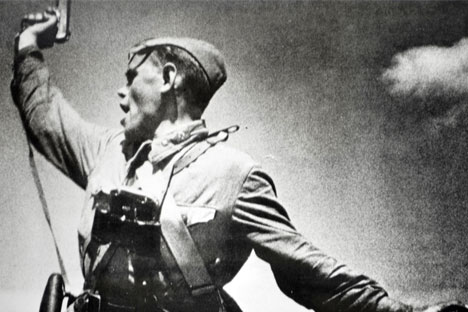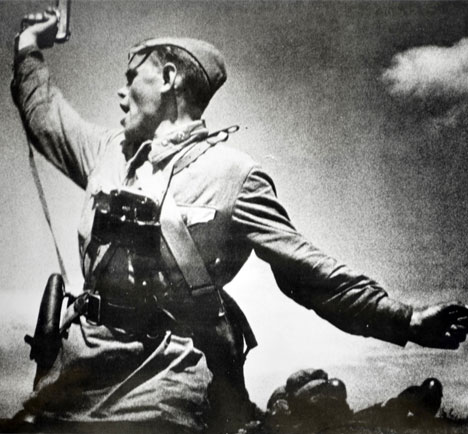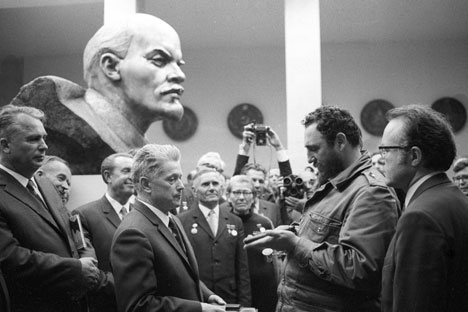

Soviet junior political officer armed with a Tokarev TT-33 Service Pistol urges Russian troops forward against German positions during World War II, 1942. Source: Universal History Archive / UIG via Getty Images
After the Russian Civil War ended in the early 1920s, the Red Army decided to replace the legendary 19th-century Nagan and Mauser pistols with more modern weapons. For economic and manufacturing reasons these would have to use Mauser 7.63 mm cartridges, which are accurate and have a high initial velocity, but also lack stopping power.
The designs put forward by Soviet gunsmiths had to match up to the best pistols in world service, the Browning, Walther and the Parabellum (Luger). Based on the 1903 Browning and firing modified 7.62 x 25 mm Mauser rounds, Fedor Tokarev’s pistol beat out the competition.
Following testing in 1930, a state review commission concluded that the pistol would be suitable for adoption “on the condition that shortcomings are corrected.”
Along with innovative solutions like the short-barrel recoil, a modification of the Browning’s swinging link and a one-piece hammer mechanism, the pistol still had some significant drawbacks, including its lack of a safety catch. Wear to the hammer’s half-cock safety feature could cause a negligent discharge if the pistol was jolted or dropped.
Due to the high number of self-inflicted injuries involving the TT, Soviet investigators were even trained to distinguish real from staged negligent discharges at a crime scene. Meanwhile, complaints grew about the TT’s ergonomics, which were the result of cost-cutting in manufacture.
The first samples of the weapon entered service in 1931 as the ‘7.62 mm self-loading Tokarev pistol model 1930.’ It soon became known by the city of its production and designer’s name, Tula-Tokarev, or simply TT.
After final improvements the pistol entered service as the TT-33. It quickly won over the army and security forces for its long-range accuracy, comparable to that of the Mauser, high initial power and flat form which allowed easy concealment beneath clothing.
The pistol saw action in Spain, the border conflict with Japan and the Winter War with Finland, and by 1941 and the Soviet Union’s entry into World War II the TT was being mass-produced.
Some 600,000 units were issued to the Red Army and a further 100,000 each year thereafter, even after the evacuation of the Tula plant during the Nazi advance. Production resumed there in 1942, and with the output of the Izhevsk and Kovrov plants, more than one million TT’s were manufactured by the 1950s.
After the war, the pistol went into service in other socialist countries which also began producing them under license and selling worldwide. Even after the pistol was formally withdrawn from service in 1951, it could be found in Soviet army and police units for another decade and more.

Former Belarussian partisans giving a souvenir to Fidel Castro - TT pistol. Source: M. Gankin / RIA Novosti
In the 1990s, at the height of gangster mayhem that engulfed Russia after the collapse of the Soviet Union, the TT returned to prominence in the context of gang killings and assassinations.
Today, the TT is often presented as an award in Russia for distinguished service and is still carried by bailiffs, courier service and cash collection and delivery service personnel.
Experts estimate that some three million TT units were produced in total around the world. Many are unused and kept in storage, with periodic emissions onto the market where they are snapped up by collectors, especially in the United States. Russia also competes on the market with China, which still produces licensed commercial versions of the TT.
But despite the pistol’s legendary status, Russian experts are still weighing up its pros and cons.
Afghan war veteran and the former interior ministry weaponry chief Yury Karpechenko rates the TT as the best pistol ever made, matched only by the Austrian Glock among Western models.
“We still use the TT and the Mauser when testing bulletproof vests,” Karpechenko said. “I have yet to meet the vest that can take a round from a TT.” And what it lacks in stopping power it makes up for with accuracy, he believes.
Firearms expert Vladimir Kislov of the Dynamo defensive systems center regards the TT as hopelessly outdated and with many failings, including its small caliber, missing safety catch and need for excessive pressure on the trigger to fire.
A senior staff member of Russia’s Museum of the Armed Forces, Sergei Plotnikov, also notes the sharp recoil, heavy cartridge weight and insufficient stopping power: “You can hit a target several times and still not drop it if you do not hit the head or vital organs.”
And yet Plotnikov also calls TT “one of the best pistols ever,” comparable to the German-made Walther P38 and SIG Sauer.
Click to view the infographics
All rights reserved by Rossiyskaya Gazeta.
Subscribe
to our newsletter!
Get the week's best stories straight to your inbox